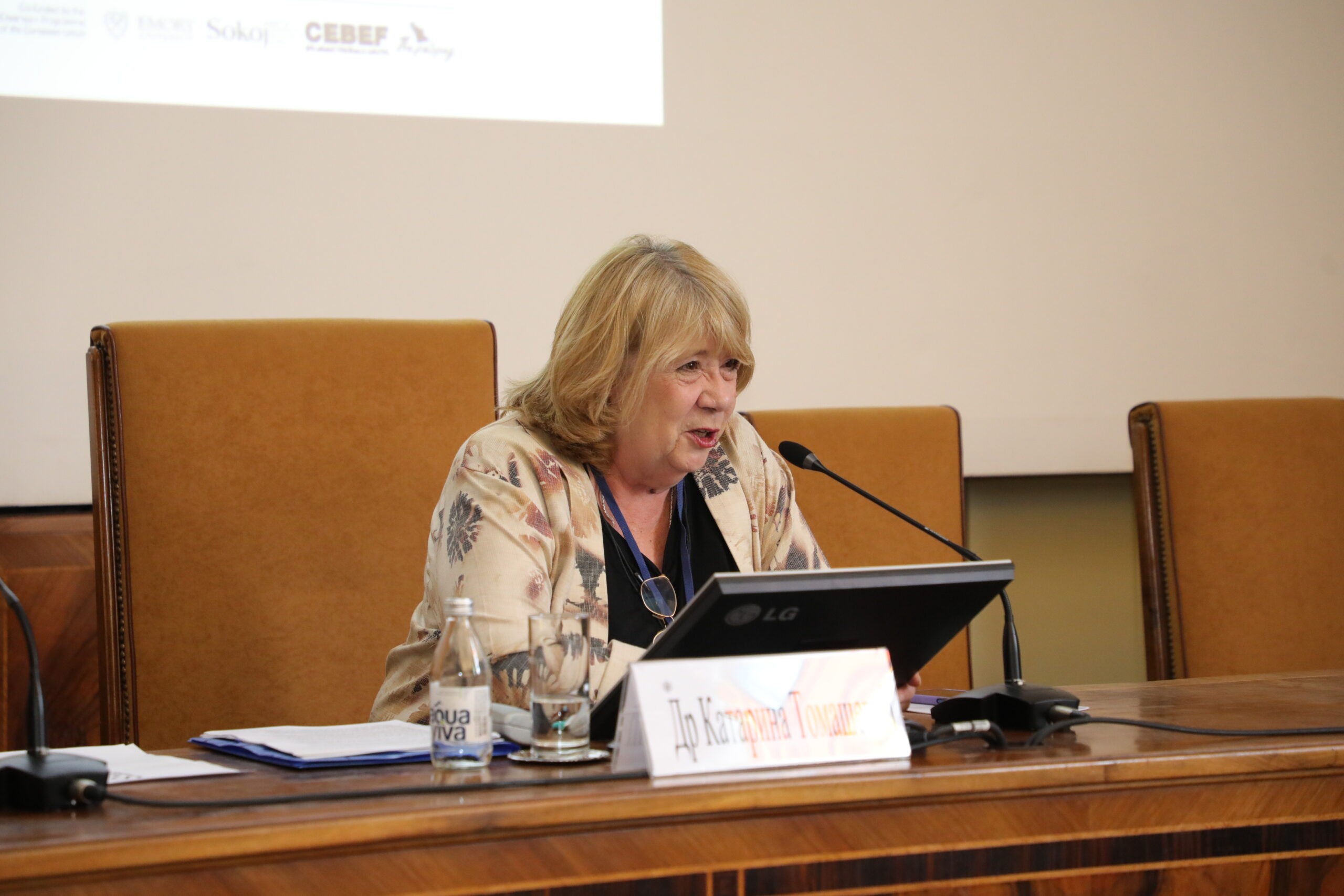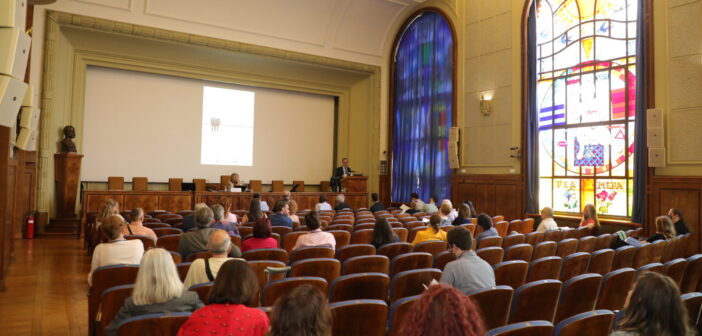In May of this year, I found myself among leading musicologists and composers attending the Ninth International Conference on Music and Minimalism in my hometown of Belgrade, Serbia.
Inside the opulent Great Hall of the Serbian Academy of Sciences and Arts (SASA), the attentive audience listened as University of London Professor Keith Potter explained the intricacies of Steve Reich’s work tapes from Music for 18 Musicians. Across the street, distant but persistent, a Roma brass band played Goran Bregović’s Mesečina (Moonlight) from the original soundtrack of Emir Kusturica’s 1995 Palme d’Or winning film, Underground.
As Keith Potter’s academic analysis of one of America’s great contemporary composers was punctuated by the upbeat, chaotic, and mournful soul of Balkan folk-inspired pop music, I glanced over at my Western colleagues in amusement. It will take them some time to adjust to—and make sense of—this postmodern soundscape, I recall thinking to myself.
Aptly themed Minimalist Intersections, the conference aimed to highlight minimalist artists from countries outside “the Anglo American and Western European mainstream—including, but not limited to Central, Eastern, Southern, and Northern Europe.” Belgrade was the perfect place to host the event, as it combines eastern and western influences into its own complex identity.
Belgrade reflects the multi-layered cultural and historical characteristic of the Western Balkans. Invaded and defended numerous times in its history, Serbia’s capital is home to a proud people whose independence has been obtained at great cost over centuries of struggle. Located on a pedestrian street in the heart of the Old Town district which leads up to the 2000-year-old Kalemegdan fortress overlooking the junction of the Sava and Danube rivers, the SASA beats with the pulse of a vibrant city, its Habsburg architecture, Orthodox churches, medieval arches, socialist facades, and famed night-life.
Organized by the Society for Minimalist Music from May 29th to June 2nd, the conference drew world-renown experts on compositional legends such as Philip Glass, Steve Reich, John Adams, or LaMonte Young together to share their knowledge and learn about overlooked minimalist composers from Eastern and Northern Europe, South America, and Japan. The result was a meeting of worlds, eye-opening for all the attendees.

Dr. Katarina Tomašević, Director, Musicology Institute of the SASA, Photo c/o Serbian Academy of Sciences and Arts
My own history is closely intertwined with the emergence of minimalist music in the Western Balkans. In the 1970s, four brash young composers made waves in the conservative Belgrade musical circles by composing in a style based on short, repetitive musical units distilled down to the most essential components of rhythm, meter, harmony, melody, and timbre. The founding members of Opus 4 were Milimir Drašković, Vladimir Tošić, Miroslav Miša Savić, and my father Miodrag Lazarov Pashu. The group’s reductive and avant-garde artistic principles informed their work in the visual arts, performance-art, and music, methodically analyzed in their theoretical writings.
Growing up, I was surrounded by their recordings, and books written about their epoch-defining work. However, I had only been peripherally aware of my father’s involvement in a cultural movement that would become part of the history of Serbian contemporary music, until I started performing works by Opus 4 members a few years ago.
The contribution of Opus 4 to the development of musical and artistic thought in their home country was presented at the conference through an exhibit, multiple concerts, lectures, and a new publication, The Origins of Yugoslav Musical Minimalism. The beginnings of musical minimalism in Belgrade are aptly contextualized by authors Laura Emmery and Ivana Miladinović Prica, who have documented the work of both Opus 4 and the Ensemble for Different New Music, an artist collective assembled by composer Miloš Raičković and others. The photographs, press clippings, programs, album covers, and original artwork displayed at the conference exhibit were a testament to the multifaceted work of these artists.
Presenting a lecture recital on the works and history of Opus 4 at the Ninth International Conference on Music and Minimalism was a defining moment in my career. I could not be prouder to share this legacy with such a distinguished audience consisting of professors and international experts on minimalist music.

Viktor Lazarov, Ph.D., performing works by Opus 4, Mokranjac Music School, Photo c/o Musicology Institute of the SASA
Stylistically, the works I performed extended from core minimalism to post-minimalism, drawing on post-romantic inspiration. Vladimir Tošić’s Retida consists of repetition of rapidly alternating intervals based on the tones of the harmonic series; its symmetric arch-like structure culminates halfway through the piece, before returning to its initial point of repose in C major. Even more radical, Milimir Drašković’s HPSCH 2 employs a progressively diminishing number of repetitions of a series of 12 chord, realized in the form of the Alberti bass.
The first of two post-minimalist works was Lazarov Pashu’s Waltz, a highly personal rendition of the form using phrases of irregular length, which erupts in a combustive midsection and brings back the original, contemplative theme to a close. In the days preceding my performance, I had rehearsed the final work, Miroslav Savić’s Ground, over the course of a series of late-night sessions with the composer. The most eclectic one of the bunch, Ground makes use of a haunting electroacoustic part projected on tape, adding an ethereal dimension to the solo piano variations on a theme.
My lecture-recital traced each composer’s solo piano output beyond the initial period of their involvement with the group (1976 to 1982). I discussed the historical context of Opus 4, their clash with authoritative figures at the Academy of Music of the University of Belgrade in the Belgrade Music Academy (in 1973 renamed the Faculty of Music of the University of Arts in Belgrade), and their emergence as a professional avant-garde collective supported by the Student Cultural Centres in Belgrade, Zagreb, and many other centres across Yugoslavia, as well as in Eastern and Western Europe.
The variety of lectures and topics presented at the conference were a testimony to the richness of a style that had been criticized many times for its so-called creative paucity. Minimalist music, as a general style, has been adapted through the imagination of composers stretching across geographic, political, and cultural landscapes.
Some of the lectures and performances that I remember most vividly are Kristen Wallentinsen’s analysis of auditory multistability in the works of Steve Reich (Rutgers University, Mason Gross School of the Arts, USA); David Kirkland Garner’s tempo analysis in multiple recordings of Philip Glass Piano Etudes and the performance of his own works (University of South Carolina, School of Music, USA); Ivana Miladinović Prica’s account of the Ensemble for Different New Music (University of Arts, Faculty of Music, Belgrade, Serbia); Elena Dubinets’ research into the minimalism of Ukrainian and post-Soviet composers (London Philharmonic Orchestra, UK); Paul David Kean’s performance of John Adams’ China Gates, I Still Play, and Phrygian Gates (independent performer and researcher, South Wales, UK); and Miloš Raičković’s workshop on Water Tones involving an improvised live performance with several conference participants (independent composer and researcher, NY, USA).
The Ninth International Conference on Music and Minimalism will publish its proceedings next fall. For more information: https://societymusictheory.org/events/ninth-international-conference-music-and-minimalism-2024
Book Reference: Laura Emmery and Ivana Miladinović Prica, The Origins of Yugoslav Musical Minimalism: Exhibition at the Cultural Center Parobrod. Belgrade: UK Parobrod and G.L.O.R.I.A, 2024.
Ivana Medić (ed.), The Ninth International Conference on Music and Minimalism: MINIMALIST INTERSECTIONS. Belgrade: Serbian Academy of Sciences and Arts, and the Institute of Musicology SASA, 2024. https://dais.sanu.ac.rs/
handle/123456789/16595













